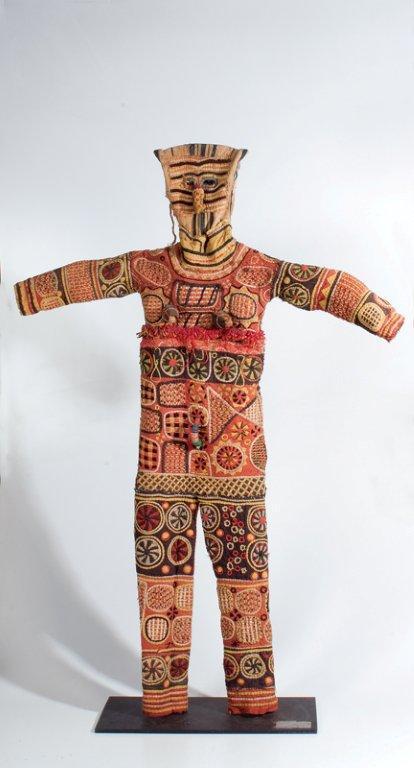Maiden Spirit Costume (Agbogho mmuo)
20th century
A young man once dressed in this suit to showcase the ideals of youthful feminine beauty. As part of a season of masquerade, an orchestra comprised of flute, drum and slit gongs would warm up the audience. He/she walks into the community plaza with the grace and dignity that befits a woman of fine upbringing. Intricate dance sequences unfold, testing the agility and rhythmic timing of the dancer. Occasionally the maidens might be taunted by a bawdy older male masker. Young women’s reactions to such forces around them are imitated and exaggerated, and can be accompanied by sayings which emphasize that their physical and moral beauty are equally considered. Praise salutes are offered to those who are deemed to glow with purity and generosity.
Maiden suits are covered with dense details that represent the painted body designs known as uli. Red and yellow camwood powders, along with white chalk, are applied in what is a women’s art. Uli graphics are applied with a thin sliver of wood to the human canvas, becoming a subtle cosmetic art. For a thin girl, bold patterns will be chosen, while a corpulent woman will be covered in delicate tracery. Witty line play and inventiveness are renowned, as uli designs also have symbolic references that often deal with the fact that often “beauty excites jealousy.” This example is in keeping with the allure of slight asymmetry, which adds constant variation to each section of the suit.
Cotton, wool, burlap
Gift of Dr. Oliver E. and Pamela F. Cobb
2011.31
Provenance: Collected in Nigeria by Dr. Glen and Pamela Rhodes, Virginia; [Arte Primativo, Howard Rose Gallery, New York, auction on December 13, 2011, lot no. 424]; purchased at auction by Dr. Oliver E. Cobb, Seattle

